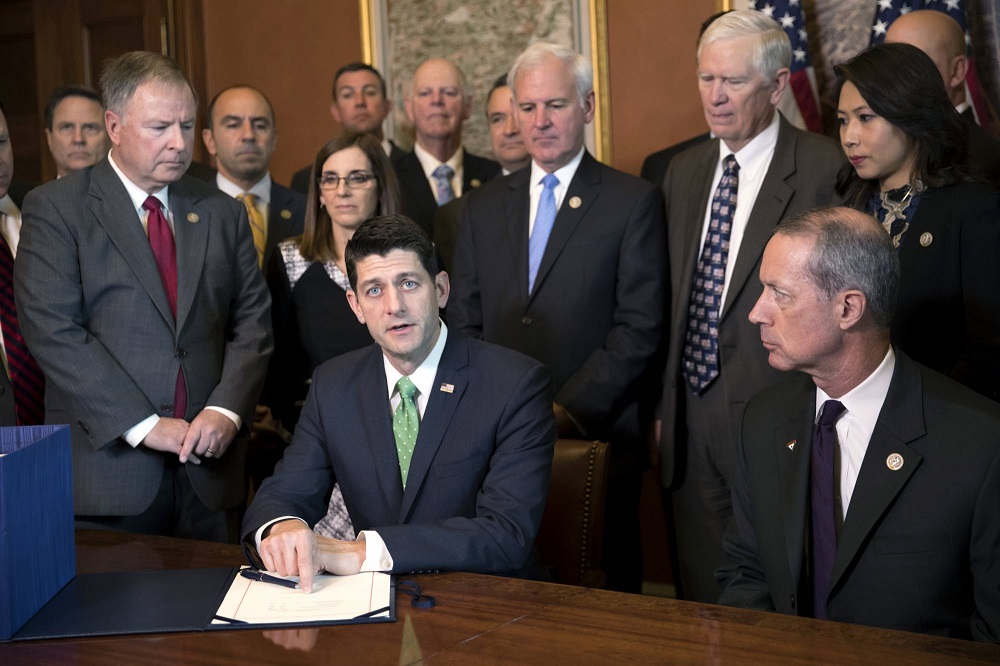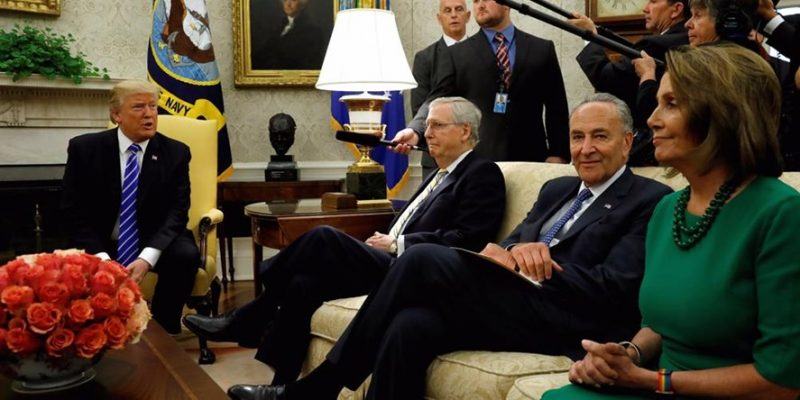
In the past, the threat of a government shutdown would be screaming from the headlines, but with the Donald Trump White House, this seems rather quaint now.
With so many other divisive things happening, Congress realized that allowing a shutdown would only hurt things more and are putting a quick Band-Aid on the problem. Yes, they are kicking the can down the road but only for a couple of weeks this time.
Congress seems set to prevent a weekend government shutdown, but lawmakers and President Donald Trump still have longer-range disputes to settle over spending, immigration, and other issues before they can declare budget peace.
With many on both sides deciding a headline-grabbing federal closure would be a political blunder — at least for now — the House planned to approve legislation Thursday financing federal agencies through Dec. 22. The Senate seemed ready to follow. Without legislation, many agencies would run out of money after midnight Friday and grind to a close.
The two-week spending measure is aimed at giving both parties’ bargainers more time to reach longer-term budget decisions. To jumpstart that negotiating, Trump and congressional leaders were meeting Thursday to try reaching agreements.
The prospects for successful White House talks were buffeted Wednesday when the impulsive Trump blurted to reporters that a shutdown “could happen.” He blamed Democrats, saying they want “illegal immigrants pouring into our country, bringing with them crime, tremendous amounts of crime.”
Last week, an unexpected attack by Trump on House Minority Leader Nancy Pelosi, D-Calif., and Chuck Schumer, D-N.Y., prompted the two Democrats to skip a bargaining session that was planned then.
This time, the White House smoothed the waters by following up with a more peaceable, written statement. It praised Pelosi and Schumer for choosing to “put their responsibility to the American people above partisanship” and said Trump was anticipating productive talks between “leaders who put their differences aside.”
Later, the White House issued another statement indicating Trump would sign the two-week spending extension. It also laid out administration budget goals, saying money for the military including missile defense and security along the border with Mexico “must be prioritized in a long-term funding agreement.”
For Republicans, a shutdown would put a humiliating bookend on a year in which they’ve controlled the White House and Congress with little to show for it. They want the public to focus instead on the GOP’s prized $1.5 trillion tax bill, which party leaders hope to send Trump by Christmas.
The two-week spending bill also makes money available to several states that are running out of funds for the Children’s Health Insurance Program. That widely popular program provides medical care to more than 8 million children.
Even the head of the conservative House Freedom Caucus, whose members have been threatening to oppose the temporary spending measure, predicted passage.
“No one wants a shutdown, including Freedom Caucus members,” Rep. Mark Meadows, R-N.C., told reporters.
The roughly 30-member caucus has been trying to win promises from leaders of spending curbs and quick passage of a full-year defense budget in exchange for backing the short-term bill. Without support from many of them, Republicans would need votes from Democrats to push the temporary spending measure through the House.
While many Democrats seemed likely to oppose the short-term bill, enough were expected to support it in the Senate to allow its passage there. They know they’d still have leverage on subsequent bills needed to keep the government running.
Republicans control the Senate 52-48 and will need at least eight Democratic votes for passage.
Democrats have been using their leverage to insist on spending boosts for health care, infrastructure and other domestic programs that would match increases Republicans want for defense.
Democrats are also seeking an agreement to extend protections for hundreds of thousands of immigrants who arrived in the U.S. illegally as children. Trump ended safeguards against deportation three months ago but has expressed an openness to restoring them.
The Three Things That Can Lead To A Government Shutdown
Timing
House Republicans introduced a bill that would keep the government funded at the current levels for another two weeks over the weekend. The House Rules Committee was supposed to meet to discuss the bill Tuesday, and the full House was expected to vote Wednesday. However, pushback from some conservatives within the caucus forced everything to be delayed by at least a day. Even if it sails through the House without a hitch Thursday, it must still make it through the Senate. While there are enough Republicans in the House to pass legislation along party lines, the narrow GOP margin in the Senate means at least eight Democratic votes will be needed to approve a spending bill.
After it’s made it through both chambers, the bill has to be signed by President Trump. Depending on what time that is done, the president may not be in the White House; he may be in Florida Friday night for a campaign rally. However, Trump’s aides could use a mechanical device known as the “autopen” to sign the legislation if he isn’t in the White House. Former president Barack Obama used the device multiple times, including on a two-week highway funding bill.
Military funding
GOP leaders in the House have faced pushback from conservatives who want a guarantee that military funding won’t get caught up in the next round of budget talks.
House conservatives say they’ll be more inclined to support a short-term spending bill if the next time one comes up — as soon as the end of this month — it doesn’t include military spending. They’d like to see defense spending put into its own bill and funded through the end of the fiscal year. Conservatives believe in an increase in military funding, but they’d like to hold the line on non-defense spending. Democrats support increasing defense and non-defense spending equally.
Hardline conservative House Freedom Caucus Chair Mark Meadows, R-N.C., has been in and out of negotiations with House Speaker Paul Ryan, R-WIs., over the last two days. He told reporters that he’d be open to adding Democratic priorities to the separate bill to try and force Democrats to support it in the Senate
One of those may be legislation co-sponsored by GOP Sen. Lamar Alexander of Tennessee and Democratic Sen. Patty Murray of Washington that is designed to stabilize the insurance markets created by the Affordable Care Act by giving subsidies to insurance companies.
Conservatives say that bill is a bailout to insurance companies. But on Wednesday Meadows said he thought “many’ conservatives would be willing to combine that legislation with defense funding if it meant getting Democratic support.
Immigration
Many Democrats — and a growing number of moderate Republicans — are calling on Congress to find a permanent solution before the end of the year for the 800,000 undocumented immigrants who came to the U.S. as children and received protection under an Obama-era executive order.
In September, Trump ended that order and gave Congress six months to come up with a solution. Republican leaders say there is no reason to rush what needs to be a bipartisan negotiation on how to protect those covered by Deferred Action for Childhood Arrivals (DACA), called Dreamers, and help prevent future illegal immigration.
But Democrats say the issue needs to be dealt with before the end of the year and some are even threatening to hold government funding hostage over the issue.
Republicans “are willing to enter into good faith negotiations. But it simply does not advance the interests of these DACA recipients to try to force this into a shut-down narrative and to jeopardize our national security and other governmental functions just in order to help these young adults,” Texas Sen. John Cornyn, the No. 2 Republican in the Senate, told reporters Wednesday. “We do want to resolve this, but it’s not going to be before the end of this year.”
But Illinois Sen. Dick Durbin — who is leading the call to pass a bill before the end of the year that would provide a pathway to citizenship for DACA recipients — said that what Republican leaders have presented so far “cannot be considered a good faith effort to provide protection for the Dreamers.”
Trump said Wednesday that a shut-down was possible because of Democrats.
“The Democrats may … want to shut down the country because they want people flowing into our country,” said Trump during a Cabinet meeting, referring to illegal immigration.
House Minority Leader Rep. Nancy Pelosi, D-Calif., replied in a tweet that Trump is the only one talking about a shutdown. “Democrats are hopeful the president will be open to an agreement to address the urgent needs of the American people and keep government open,” she said.
Trump, Pelosi, Ryan, Senate Minority Leader Chuck Schumer, D-N.Y., and Senate Majority Leader Mitch McConnell, R-Ky., are scheduled to meet Thursday to discuss funding, and immigration is bound to come up.
In a statement Thursday White House spokeswoman Lindsay Walters said that Trump was “pleased” the Democrats had decided to attend the meeting and that the administration “hopes to find fiscally responsible ways to avoid a government shutdown, address the looming sequester and devastating cuts facing our military, as well as fund important domestic priorities that will encourage economic prosperity and keep
Americans safe.”


